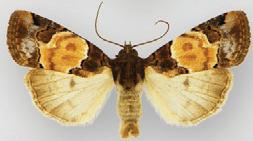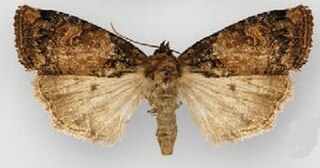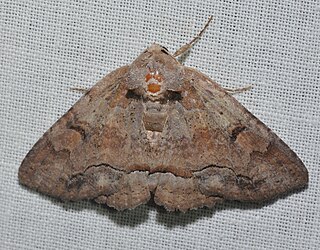
The Noctuidae, commonly known as owlet moths, cutworms or armyworms, are a family of moths. They are considered the most controversial family in the superfamily Noctuoidea because many of the clades are constantly changing, along with the other families of the Noctuoidea. It was considered the largest family in Lepidoptera for a long time, but after regrouping Lymantriinae, Catocalinae and Calpinae within the family Erebidae, the latter holds this title now. Currently, Noctuidae is the second largest family in Noctuoidea, with about 1,089 genera and 11,772 species. This classification is still contingent, as more changes continue to appear between Noctuidae and Erebidae.

Bryophilinae is a subfamily of moths in the family Noctuidae. The subfamily was erected by Achille Guenée in 1852.

Bryolymnia is a genus of moths of the family Noctuidae erected by George Hampson in 1908.

Cryphia is a genus of moths of the family Noctuidae. The genus was erected by Jacob Hübner in 1818.

Euxoa is a genus of moths of the family Noctuidae raised to Genus by the German entomologist, Jacob Hübner. The Genus is mostly confined to dry and semi dry areas in the Northern Hemisphere. There 130 species in Eurasia, a few in Africa, and 175 in North America. There are no species in the Genus in South-East Asia or in Australia. In North America, most species are found in Western regions. Of the North American species, 4 are endemic to Mexico. There is one species recorded from Chile, but this may be a mislabeled specimen. In real terms, species numbers do not equal species abundance. Some areas with few species have large numbers of the ones that do live there.

Metalectra is a genus of moths of the family Erebidae described by Jacob Hübner in 1823.

Gondysia smithii, or Smith's darkwing, is a moth of the family Noctuidae. The species was first described by Achille Guenée in 1852. It is found in the United States, from North Carolina southward to Georgia and westward to Texas northward in the Mississippi Valley to Missouri. It has recently been recorded from Virginia and Florida but not yet from Louisiana or Arkansas, although it does occur close by and would be expected in those states as well. It occurs in open savanna and mesic woodland habitats.

Bryolymnia viridata is a moth of the family Noctuidae first described by Leon F. Harvey in 1876. It is found in the US in western California from Sonoma County north of San Francisco southward to San Diego County.

Hypotrix ferricola is a moth of the family Noctuidae first described by Smith in 1905. It is found in southern North America from south-eastern Arizona, south-western New Mexico and northern Mexico.

Bryolymnia bicon is a moth of the family Noctuidae first described by Herbert Druce in 1889. It is found from Veracruz in central-eastern Mexico southward to Costa Rica.

Bryolymnia mixta is a moth of the family Noctuidae first described by Donald Lafontaine and J. Walsh in 2010. It is known only from the Patagonia Mountains in south-eastern Arizona.

Bryolymnia biformata is a moth of the family Noctuidae first described by Donald Lafontaine and J. Walsh in 2010. It is known only from the Huachuca, Patagonia, and Santa Rita Mountains in south-eastern Arizona.

Bryolymnia poasia is a moth of the family Noctuidae first described by William Schaus in 1911. It is found in Costa Rica.

Bryolymnia semifascia, the half-banded bryolymnia, is a moth of the family Noctuidae. The species was first described by John Bernhardt Smith in 1900. It is found in the US from northern Colorado and southern Utah southward to south-eastern Arizona and south-central New Mexico.

Bryolymnia picturata is a moth of the family Noctuidae first described by William Schaus in 1894. It is found in south-eastern Mexico.

Bryolymnia ensina is a moth of the family Noctuidae first described by William Barnes in 1907. It occurs in coniferous forests from south-eastern Arizona and south-western New Mexico southward in the Sierra Madre Occidental to the state of Durango in Mexico.
Noctuini is a tribe of owlet moths in the family Noctuidae. There are at least 520 described species in Noctuini.
Perigonica pectinata is a species of cutworm or dart moth in the family Noctuidae. It was described by Smith in 1943 and is found in North America.

Tesagrotis corrodera is a species of cutworm or dart moth in the family Noctuidae. It was described by Smith in 1907 and is found in North America.

Zale confusa, the confused zale moth, is an owlet moth in the family Erebidae. The species was first described by James Halliday McDunnough in 1940. It is found in North America.
This page is based on this
Wikipedia article Text is available under the
CC BY-SA 4.0 license; additional terms may apply.
Images, videos and audio are available under their respective licenses.










